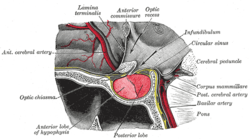Mammillary body
| Mammillary body | |
|---|---|
 The hypophysis cerebri in position. Shown in sagittal section. (Label "corpus mamillare" at right.) | |
 Coronal section of brain through intermediate mass of third ventricle. (Label "corpora mamillaria" at bottom.) | |
| Details | |
| Part of | Midbrain |
| System | Limbic |
| Components |
medial mammillary nucleus lateral mammillary nucleus |
| Identifiers | |
| Latin |
Corpus mamillare (Plural: Corpora mamillaria) |
| Acronym(s) | mmb |
| MeSH | A08.186.211.730.385.357.362.500 |
| NeuroNames | hier-395 |
| NeuroLex ID | Mammillary body |
| TA | A14.1.08.402 |
| FMA | 74877 |
The mammillary bodies are a pair of small round bodies, located on the undersurface of the brain that, as part of the diencephalon, form part of the limbic system. They are located at the ends of the anterior arches of the fornix.[1] They consist of two groups of nuclei, the medial mammillary nuclei and the lateral mammillary nuclei.[2]
Neuroanatomists have often categorized the mammillary bodies as part of the hypothalamus.[3]
Structure
Connections
They are connected to other parts of the brain (as shown in the schematic, below left), and act as a relay for impulses coming from the amygdalae and hippocampi, via the mamillo-thalamic tract to the thalamus.
This circuit, from amygdalae to mammillary bodies, and then on to the thalamus, is part of the larger Papez circuit.
Function
Mammillary bodies, and their projections to the anterior thalamus via the mammillothalamic tract, are important for recollective memory.[4] The medial mammillary nucleus is mainly responsible for the spatial memory deficits that are seen in rats with mammillary body lesions.[4]
Clinical significance
Damage to the mammillary bodies due to thiamine deficiency is implied in pathogenesis of Wernicke-Korsakoff syndrome. Symptoms include impaired memory, also called anterograde amnesia, suggesting that the mammillary bodies may be important for memory. Lesions of the medial dorsal and anterior nuclei of the thalami and lesions of the mammillary bodies are commonly involved in amnesic syndromes in humans.[5]
Mammillary body atrophy is present in a number of other conditions, such as colloid cysts in the third ventricle, Alzheimer’s disease, schizophrenia, heart failure, and sleep apnea. In spite of this the exact function of the mammillary bodies is still not clear.[4]
Additional images
-

Brain
-
Human brainstem anterior view
-

Basal view of a human brain
-

Mammillary body shown in red(animation)
-
Mammillary body
-
Cerebrum. Deep dissection. Inferior dissection.
-
Cerebral peduncle, optic chasm, cerebral aqueduct. Inferior view. Deep dissection.
-
Cerebral peduncle, optic chasm, cerebral aqueduct. Inferior view. Deep dissection.
-
Cerebrum.Inferior view.Deep dissection.
-
Cerebrum.Inferior view.Deep dissection.
-
Cerebrum.Inferior view.Deep dissection.
-
Cerebrum. Optic and olfactory nerves.Inferior view. Deep dissection.
-
Medial surface of cerebral hemisphere.Medial view.Deep dissection.
-
Medial surface of cerebral hemisphere.Medial view.Deep dissection.
-
Medial surface of cerebral hemisphere.Medial view.Deep dissection.
-
Cerebrum. Inferior view.Deep dissection
-
Cerebrum. Inferior view.Deep dissection
See also
References
- ↑ "Mammillary Bodies". Springer Reference. Retrieved 2013-06-03.
- ↑ Vann S, Aggleton J (2004). "The mammillary bodies: two memory systems in one?" (PDF). Nat. Rev. Neurosci. 5 (1): 35–44. doi:10.1038/nrn1299. PMID 14708002..
- ↑ M.B. Carpenter and J. Sutin: Human Neuroanatomy (8th edition) 1983
- 1 2 3 Seralynne D. Vann (2010). "Re-evaluating the role of the mammillary bodies in memory" (PDF). Neuropsychologia 48 (8): 2316–2327. doi:10.1016/j.neuropsychologia.2009.10.019. PMID 19879886.
- ↑ Duprez T, Serieh B, Raftopoulos C (1 January 2005). "Absence of memory dysfunction after bilateral mammillary body and mammillothalamic tract electrode implantation: preliminary experience in three patients". AJNR. American journal of neuroradiology 26 (1): 195–7; author reply 197–8. PMID 15661728.
External links
| Wikimedia Commons has media related to Mammillary bodies. |
- Anatomy diagram: 13048.000-3 at Roche Lexicon - illustrated navigator, Elsevier
| ||||||||||||||||||||||||||||||||||||||||||||||||||||||||||
| ||||||||||